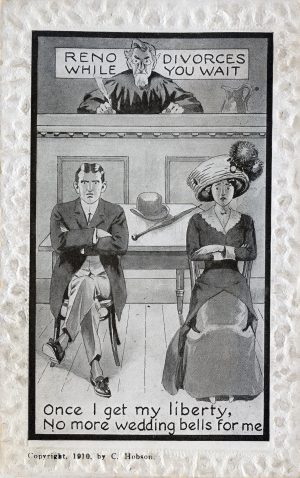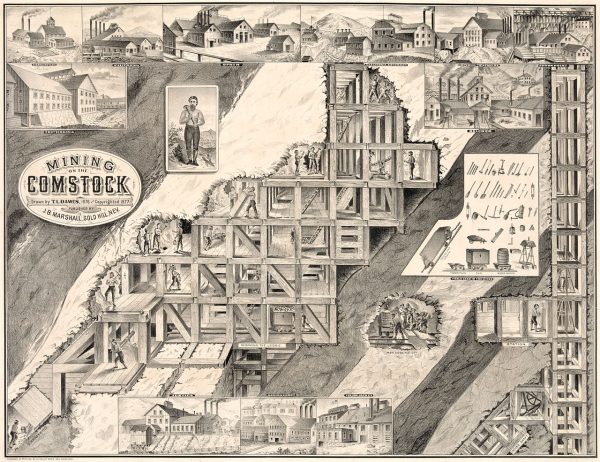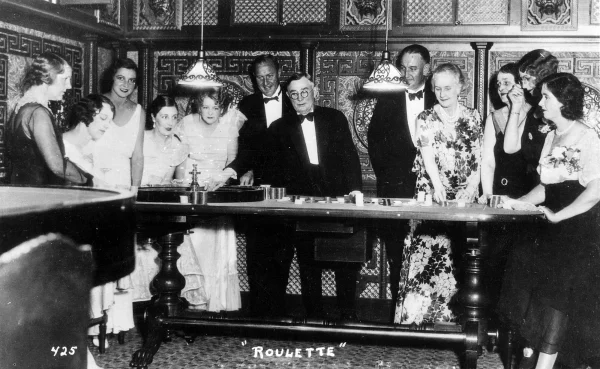In the mid-1900s, people flocked to Reno, Nevada — not for frontier gold or loose slots, but to get out of bad marriages. The city became known as the “Divorce Capital of the World.” For much of modern history, it has been relatively easy to get married, and extremely difficult to get divorced — and for a time, this was true in the New World as well.
After American independence, matters of family law were assigned to each individual state. Those regional governments had the right to set the rules for how or even if you could attain a divorce. So divorce laws varied dramatically depending on what state you lived in. While a lot of eastern states were saddled with traditional rules surrounding marriage, western states were newly colonized by white settlers and didn’t have the baggage of traditions.
Existing conditions had already drawn outsiders to Reno from its founding. In the mid 1800s, its proximity to gold and silver mines lured all kinds of people to rush Northern Nevada. Because of this, Reno was selected as a stop on the new Central Pacific Railroad, making it easy to get to by train. But the big thing Reno had going for it was its short residency period. Much of the population of Nevada was transient, meaning they would come for short periods of time to take advantage of the mining rush. Nevada lawmakers realized that if they lowered the time it took to become a resident, they could count this transient population as “permanent” and use them to gain more power in Congress.
 A shorter residency period and more liberal grounds for divorce meant that instead of getting a divorce in your actual home state, it could be much easier to become a temporary Nevada resident, secure a divorce, and then return to home. This of course made a lot of conservative politicians and social leaders in other states furious. They hated that residents could circumnavigate their own state laws and they tried to bar the legality of a Nevada-acquired divorce, but in most cases, an out of state divorce was protected by the Constitution.
A shorter residency period and more liberal grounds for divorce meant that instead of getting a divorce in your actual home state, it could be much easier to become a temporary Nevada resident, secure a divorce, and then return to home. This of course made a lot of conservative politicians and social leaders in other states furious. They hated that residents could circumnavigate their own state laws and they tried to bar the legality of a Nevada-acquired divorce, but in most cases, an out of state divorce was protected by the Constitution.
As Nevada’s gold and silver mines were depleted, politicians and businessmen in Reno were looking to take advantage of this new industry cropping up around divorce tourism. Nevada wasn’t the only Western state that noticed the economic benefit of luring in divorce-seekers. Arkansas, Idaho, and Wyoming had all lowered their residency requirements in the 1920s. Sioux Falls, South Dakota was one of the first cities to take advantage of migratory divorce and was actually known as a “divorce colony.” But when the stock market crashed in 1929 there were rumors that Idaho and Arkansas were going to match Nevada’s residency requirement which had actually been lowered to 3 months by then. The country was entering the Depression and Reno business leaders were desperate to hold tight to the one industry that remained in steady demand.
And so in 1931, Nevada passed legislation that solidified Reno once and for all as the divorce capital of the world: they changed the residency requirement, which had been six months just a few years before, to six weeks. This quick-and-easy pathway expanded access to divorce not just for the rich and famous, but everyday people who didn’t have the luxury to take months away from their busy lives. In the same legislative session that lowered Reno’s residency to an unheard of six weeks, the state of Nevada also legalized wide-open gambling. With the offer of a quickie divorce with entertainment baked in, Reno became an unbeatable destination for divorce tourists — women in particular, who represented the majority of divorce seekers.
Of course, people coming to get a divorce still had to stay for weeks, and that meant they needed somewhere to stay, and witnesses to their residency. Many guesthouse managers offered to act as this so-called resident witness as part of the divorce-seeking package deal. Of course, these stays weren’t free. But if you were a woman you could head over to the YWCA which would help set you up with a short-term gig like shop clerk, waitress, babysitter, housekeeper, stenographer. Men seeking divorces in Reno could find work as a mechanic or ranch hand.
The personal stakes were high, particularly for women, and Reno delivered: it was a refuge from social taboos, an opportunity for job experience, and a potential pathway to a more fulfilling marriage with financial security. If you managed to wear a cowboy hat, play the slots and have fun while at it, that was just a bonus. Reno’s divorce era began petering out in the late ’60s as divorce law became more liberalized throughout the Western world, but the impacts of the divorce rush remain, as does the downtown bridge from which women traditionally hurled their wedding rings once freed from unhappy marriages.
Correction: This episode originally reported that Anne Sturm was in Reno to get a divorce, it was Anne Sturm’s mother, Pat. Also, the historic “Wedding Ring Bridge” on Virginia street was replaced in 2016 by a new bridge at the same location.








Leave a Comment
Share